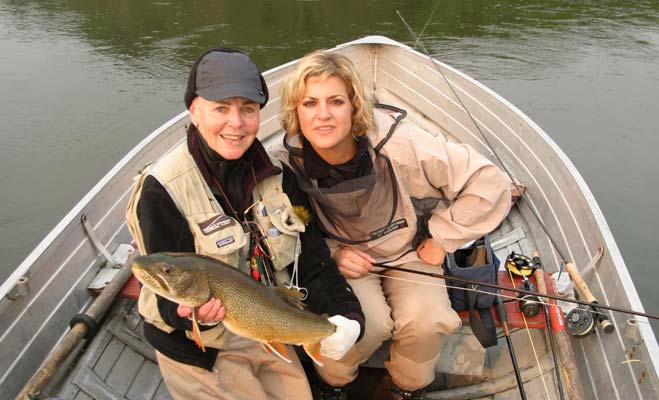Q&A with Pudge Kleinkauf
From her top flies to favorite time to fish in Alaska, Fish Alaska magazine asks longtime friend and contributing editor about her fly fishing preferences in this Q&A with Pudge Kleinkauf,

1) You guide both experienced and novice fly anglers regularly. What are the common casting mistakes you see, regardless of experience?
Pudge: Lots of fly fishers simply don’t stop the rod in the correct places. That causes the fly line to hit the water on either/both the front stop and the back stop. They just can’t get the distance they want, and they have trouble with spooking fish because of the disturbance when the fly hits the water.
Other fly fishers get a lot of wind knots in their leaders and don’t know how to avoid them. Wind knots form when the caster loses the rhythm need to make a good cast. (Remember when the dad in The River Runs Through It gets the metronome off the piano and sets it down on the grass so the boys can learn the timing for the rod tip to go back and forth?) Maintaining that rhythm will help avoid wind knots as you cast.
2) Alaska presents very different fly-fishing terrain than visitors from the Lower 48 might be used to. What would you say stands out as the most difficult thing for anglers new to Alaska to conquer when on the water?
Pudge: I think that access to the fishing is probably the most difficult thing that new fly anglers experience when coming to Alaska. They are used to driving where they’re going to fish (except for saltwater fly fishing, of course). New Alaskan fly anglers must adjust to the fact that there are few roads in Alaska, and that they may need to travel by small plane, boat, or perhaps even 4-wheelers to get to the fishing and their chosen water.
3) If you wanted to catch as many species as possible but could use only six different flies, what patterns would you choose?
Pudge: If I wanted to catch as many species of fish in Alaska as possible, I would choose the following flies (in different colors and sizes, of course): egg-sucking leech, the woolly bugger, the bunny fly, the elk-hair-caddis, the egg imitation bead, and the parachute Adams.
4) What’s your favorite time of the season to fish in Alaska? Why?
Pudge: My favorite time to fish in Alaska is late July through September. All five species of Pacific salmon are in the rivers then, and the eggs and rotting flesh that they produce definitely make all the other species get more active.
5) As an angler who’s experienced a wide range of Alaska destinations, and chased all of the state’s gamefish with a fly, what would you recommend to a traveler who could make only one trip north and wanted to experience the “quintessential Alaska fly-fishing experience”?
Pudge: I would say that the “quintessential Alaska fly-fishing experience” is one where the angler has defined for him/her self:
1. The definition of quintessential in terms of the fish they want to catch,
2. Whether they wish a trip into parts of Alaska that are rustic or off the beaten path, or perhaps one that could be experienced with or without fly-outs,
3. How much they are willing to spend. The lodges in Bristol Bay are exceptional for the range of species they can provide on one trip, but they are expensive. From rainbows to salmon, to grayling, to char, to pike, and lake trout, they usually offer the most options. Many visiting anglers, however, prefer rafting and fishing where they can really experience a particular part of Alaska, and many who can’t afford an expensive trip might choose to fish along the road system in a rented motorhome.
I love all of these types of trips and suggest that it is their consideration of these factors that will help them decide for themselves what they want their trip to Alaska to be.
###
Cecilia “Pudge” Kleinkauf has owned and operated Women’s Flyfishing, a Trout Unlimited-endorsed business, for 28 of the 44 years she has lived and fished in Alaska. She teaches women how to fish with a fly rod and guides women and couples to various locations in Alaska throughout the summer. Besides being a contributing editor for Fish Alaska magazine, Pudge is the author of four books, the most recent of which is Pacific Salmon Flies: New Ties & Old Standbys. She can be reached at www.womensflyfishing.net.
